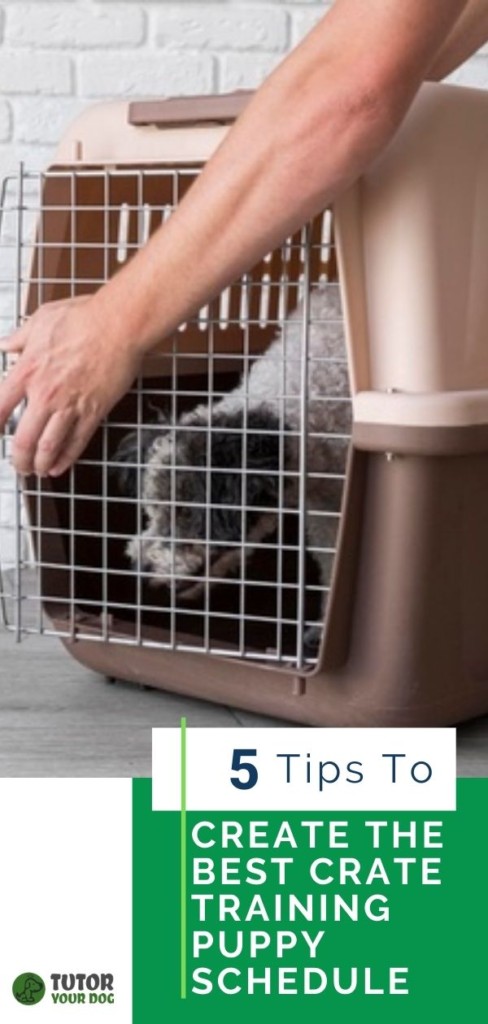{This post may contain affiliate links. This means we may make a small commission at no extra cost to you. This website is a participant in the Amazon Services LLC Associates Program. As an Amazon Associate we earn from qualifying purchases. We only recommend products that we believe will be of value to our followers. Click HERE to see our disclosure for details.}

Developing a proper crate training puppy schedule is one of the very first things you should do when you bring home your new puppy. Crate training is such an excellent tool for house training your puppy and for keeping him safe when you are unable to supervise him. Plus it provides him with his very own space, his own “den”.
Crate training provides predictability to dogs. And dogs love predictability. To know what is going to happen in any given situation makes him happy, and more apt to be the best-behaved dog he can possibly be.

Choosing A Crate For Your Puppy
A strong crate is the very basis of good puppy crate training. A wire crate or plastic crate are the best choices. Make sure it is large enough for the puppy to stand up and turn around. But not so large that he can roam and wander around. A crate that is too large will inhibit house breaking.
A crate that is just the right size will be perceived as your puppy’s den, where puppies never go potty. He will learn to hold his pee if you don’t make a prison out of it. Never leave a puppy under 8 weeks old in a crate longer than one hour. He will soil it, after struggling and suffering as long as he can.
Click on the images below to check out wire crates on Amazon.



Introducing Your Puppy To The Crate
Start with placing a tasty treat in the crate. The puppy will go in and get it. Do this several times without closing the door. Let him go in and out freely for an hour or so. Praise him highly each time he goes in, make it all very pleasant.
Then when his attention is on his treat, close the door. Praise him quietly, “What a good boy, such a good boy”! In 10 or 20 seconds, no longer, let him out without a word, no praise, just a pat. Do this for increasingly longer intervals over a few days, but do not give him a chance to get upset. You can do this several times the first day and then gradually increase the time that you keep the door closed.

Make sure every training session ends on a happy note, this is crucial.
Once he sees the crate is his own private territory, he will go in there on his own, expecting treats and your attention. When he does, say, “Go Kennel” with a happy face while getting his treats. Start leaving the room while he is in there for 2 minutes and onward, gradually. When you return, don’t make a fuss, just walk over and open the crate. Gradually increase the time that you leave the room while your puppy is in his crate. Leave him gradually longer, slowly and carefully.
Click on the images below to check out plastic and steel crates on Amazon.



Why Should You Create A Crate Training Puppy Schedule?
Puppies learn to feel very safe and secure in their crate. When placed in a crate, he feels safe because nothing can get to him or harm him. He will sleep and chew his chew toys while he waits for you to return. This will keep him out of trouble and will prevent him from developing destructive habits that can be very hard to break.
If you ever have to leave your puppy at a dog sitter’s, kennel or veterinarian clinic, he will be less stressed when he has to be crated. Of course, these places will be strange and cause him some anxiety but being used to a crate will help him settle quickly.
Crate Training Mistakes To Avoid
- Do not use it as punishment.
- Do not leave a young puppy crated for more than 2 hours, just time for a long puppy nap and some chew time. After that he will cry.
- Do not remove your puppy from his crate while he is crying. This will make him think he has to cry to get out. No matter what, make sure he is being good when you open the door. He will learn he has to be quiet to get out.
- Do not make a fuss when you are letting him out, just quietly open the door and take him out to potty. When he potties, praise him to the high heaven! Dogs naturally do not go where they sleep, but sometimes it happens. Do not scold, just clean it out with a bland face. He will learn the lesson. If possible, try to clean it while he is outside so he returns to a clean crate.
Click on the links below to check out our favorite training treats on Amazon.



Creating A Crate Training Puppy Schedule
1. Take A Look At Your Own Schedule
What does your schedule look like? If you work or need to be away from your home for long periods of time, you should plan for this in your crate training puppy schedule. Since puppies can’t hold their bladder for long periods of time, plan how you will let your puppy out for pee breaks and to stretch his legs. Maybe you can go home on your lunch break. If not, check with a neighbor or friend to see if they can let your puppy out.
Take a look at your day to see when the best times to crate your puppy will be.
2. Create Quiet Crate Times Throughout The Day
Whether you are home all day or not, it’s important to create some quiet crate time for your puppy during the day. Even if you work from home, your puppy should get used to his crate time. This way, if you do have to go out through the day and need to crate him, it won’t be stressful for him because he will already be used to sleeping in his crate.
Click on the images below to check out our favorite dog training supplies on Amazon.



3. Give Lots Of Breaks
Your puppy should not spend all of his time in a crate. Make sure you include lots of breaks outside of the crate for play sessions, feeding time, training time and time to relax outside of his crate while you are supervising. The crate is a tool and your puppy needs to learn how to behave while in and out of his crate.
4. Include Bathroom Breaks
An important part of a crate training puppy schedule is bathroom breaks. A young 8 week old puppy needs lots of bathroom breaks. Plan on arranging for your puppy to be let out of his crate every 1 to 2 hours when he is a baby puppy. If you are away from home, make arrangements for someone to look after your puppy.
5. Plan Ahead For Bedtime
Another important part of planning your crate training puppy schedule is bedtime. You want your puppy to sleep as long as possible through the night. To do this, plan a play session right before bed time. Play fetch with your puppy, do some training with him or anything that typically tires him out. This way your puppy will go to bed tired and he will be more likely to sleep through the night. Make sure that he goes outside for a potty break right before putting him to bed.
Click on the images below to check out our favorite chew toys on Amazon.



By following a schedule with your puppy, he will get used to a routine. Just like us humans, puppies like to know what is going to happen next in their day. By creating a schedule for him, he will know what is expected of him in no time at all.






